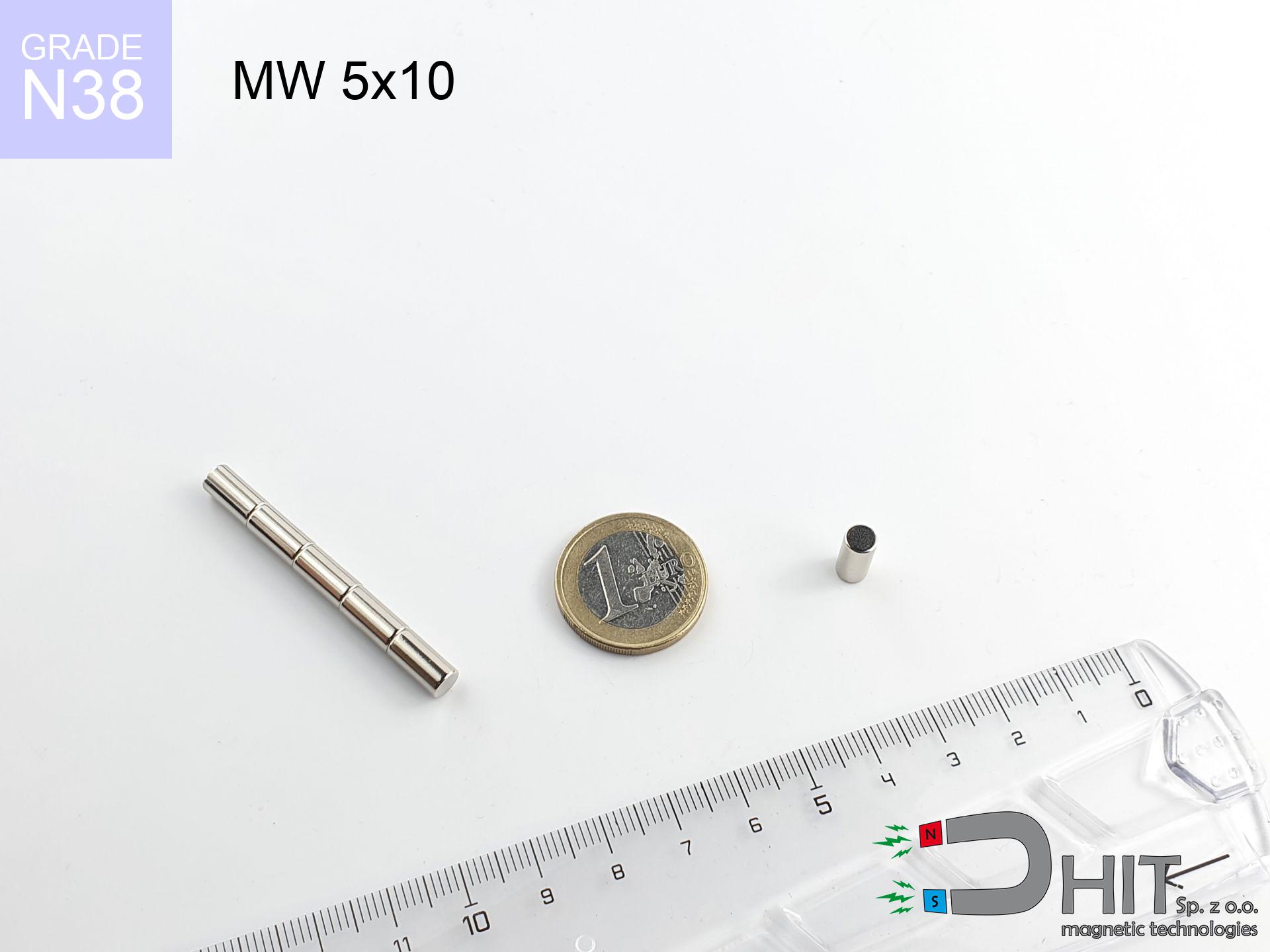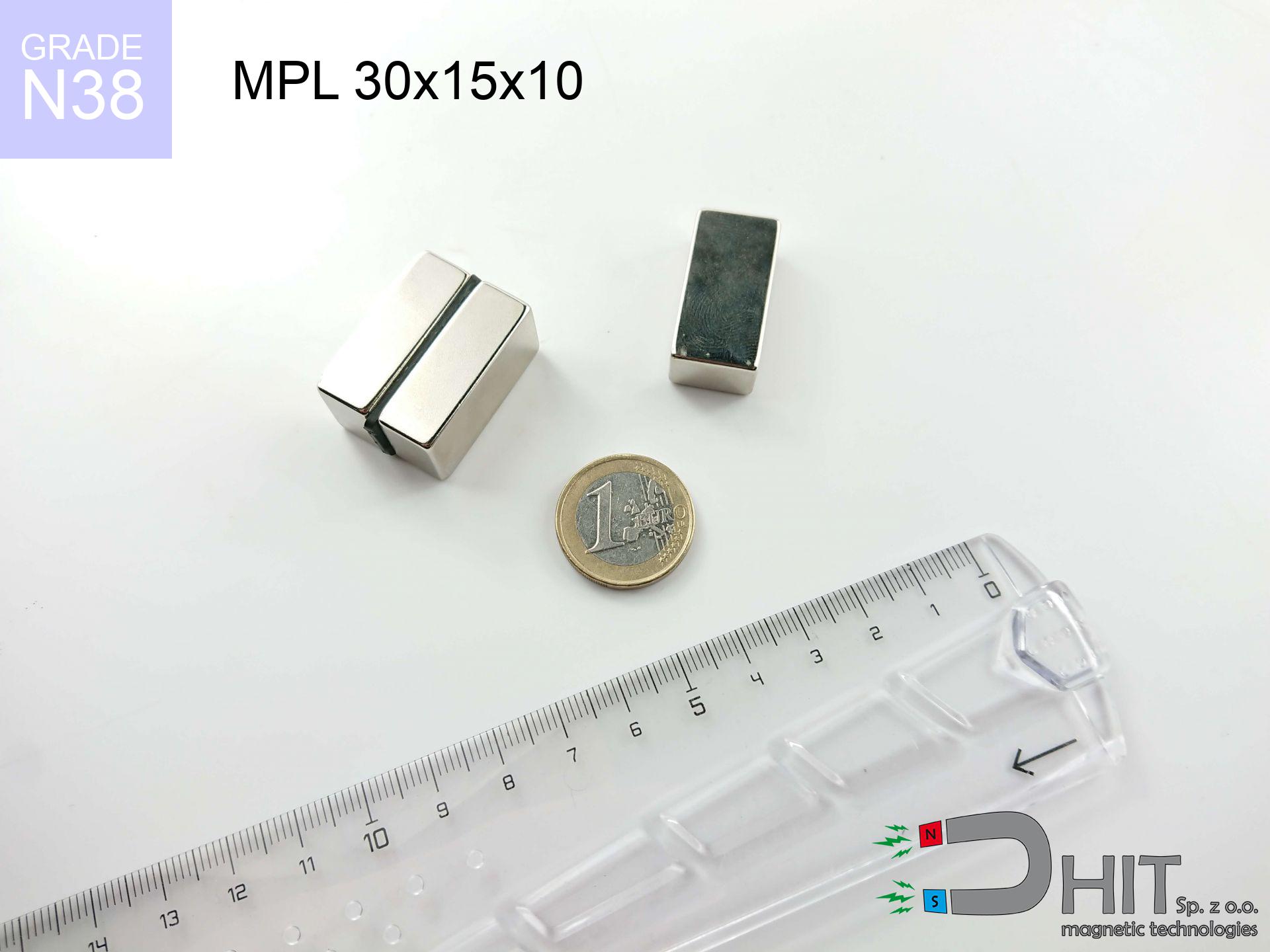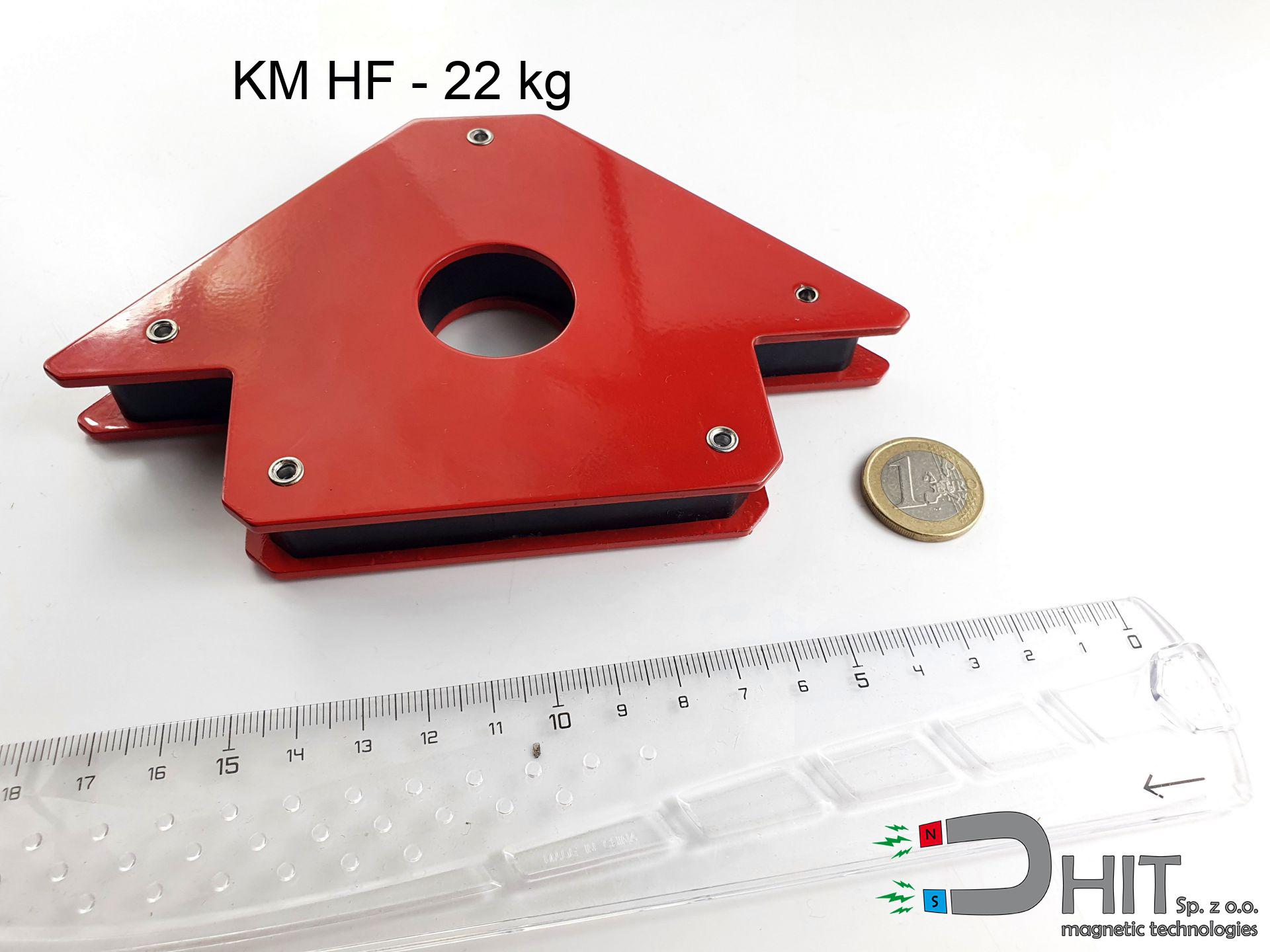MW 4x5 / N38 - cylindrical magnet
cylindrical magnet
Catalog no 010077
GTIN/EAN: 5906301810766
Diameter Ø
4 mm [±0,1 mm]
Height
5 mm [±0,1 mm]
Weight
0.47 g
Magnetization Direction
↑ axial
Load capacity
0.46 kg / 4.48 N
Magnetic Induction
573.83 mT / 5738 Gs
Coating
[NiCuNi] Nickel
0.320 ZŁ with VAT / pcs + price for transport
0.260 ZŁ net + 23% VAT / pcs
bulk discounts:
Need more?Can't decide what to choose?
Call us
+48 888 99 98 98
alternatively contact us by means of
form
the contact form page.
Specifications along with form of neodymium magnets can be checked with our
force calculator.
Same-day shipping for orders placed before 14:00.
MW 4x5 / N38 - cylindrical magnet
Specification / characteristics MW 4x5 / N38 - cylindrical magnet
| properties | values |
|---|---|
| Cat. no. | 010077 |
| GTIN/EAN | 5906301810766 |
| Production/Distribution | Dhit sp. z o.o. |
| Country of origin | Poland / China / Germany |
| Customs code | 85059029 |
| Diameter Ø | 4 mm [±0,1 mm] |
| Height | 5 mm [±0,1 mm] |
| Weight | 0.47 g |
| Magnetization Direction | ↑ axial |
| Load capacity ~ ? | 0.46 kg / 4.48 N |
| Magnetic Induction ~ ? | 573.83 mT / 5738 Gs |
| Coating | [NiCuNi] Nickel |
| Manufacturing Tolerance | ±0.1 mm |
Magnetic properties of material N38
| properties | values | units |
|---|---|---|
| remenance Br [min. - max.] ? | 12.2-12.6 | kGs |
| remenance Br [min. - max.] ? | 1220-1260 | mT |
| coercivity bHc ? | 10.8-11.5 | kOe |
| coercivity bHc ? | 860-915 | kA/m |
| actual internal force iHc | ≥ 12 | kOe |
| actual internal force iHc | ≥ 955 | kA/m |
| energy density [min. - max.] ? | 36-38 | BH max MGOe |
| energy density [min. - max.] ? | 287-303 | BH max KJ/m |
| max. temperature ? | ≤ 80 | °C |
Physical properties of sintered neodymium magnets Nd2Fe14B at 20°C
| properties | values | units |
|---|---|---|
| Vickers hardness | ≥550 | Hv |
| Density | ≥7.4 | g/cm3 |
| Curie Temperature TC | 312 - 380 | °C |
| Curie Temperature TF | 593 - 716 | °F |
| Specific resistance | 150 | μΩ⋅cm |
| Bending strength | 250 | MPa |
| Compressive strength | 1000~1100 | MPa |
| Thermal expansion parallel (∥) to orientation (M) | (3-4) x 10-6 | °C-1 |
| Thermal expansion perpendicular (⊥) to orientation (M) | -(1-3) x 10-6 | °C-1 |
| Young's modulus | 1.7 x 104 | kg/mm² |
Technical modeling of the magnet - report
Presented values represent the direct effect of a engineering analysis. Results were calculated on algorithms for the class Nd2Fe14B. Real-world performance might slightly differ from theoretical values. Treat these data as a preliminary roadmap during assembly planning.
MW 4x5 / N38
| Distance (mm) | Induction (Gauss) / mT | Pull Force (kg) | Risk Status |
|---|---|---|---|
| 0 mm |
5727 Gs
572.7 mT
|
0.46 kg / 460.0 g
4.5 N
|
weak grip |
| 1 mm |
3109 Gs
310.9 mT
|
0.14 kg / 135.6 g
1.3 N
|
weak grip |
| 2 mm |
1577 Gs
157.7 mT
|
0.03 kg / 34.9 g
0.3 N
|
weak grip |
| 3 mm |
856 Gs
85.6 mT
|
0.01 kg / 10.3 g
0.1 N
|
weak grip |
| 5 mm |
323 Gs
32.3 mT
|
0.00 kg / 1.5 g
0.0 N
|
weak grip |
| 10 mm |
66 Gs
6.6 mT
|
0.00 kg / 0.1 g
0.0 N
|
weak grip |
| 15 mm |
24 Gs
2.4 mT
|
0.00 kg / 0.0 g
0.0 N
|
weak grip |
| 20 mm |
11 Gs
1.1 mT
|
0.00 kg / 0.0 g
0.0 N
|
weak grip |
| 30 mm |
4 Gs
0.4 mT
|
0.00 kg / 0.0 g
0.0 N
|
weak grip |
| 50 mm |
1 Gs
0.1 mT
|
0.00 kg / 0.0 g
0.0 N
|
weak grip |
MW 4x5 / N38
| Distance (mm) | Friction coefficient | Pull Force (kg) |
|---|---|---|
| 0 mm | Stal (~0.2) |
0.09 kg / 92.0 g
0.9 N
|
| 1 mm | Stal (~0.2) |
0.03 kg / 28.0 g
0.3 N
|
| 2 mm | Stal (~0.2) |
0.01 kg / 6.0 g
0.1 N
|
| 3 mm | Stal (~0.2) |
0.00 kg / 2.0 g
0.0 N
|
| 5 mm | Stal (~0.2) |
0.00 kg / 0.0 g
0.0 N
|
| 10 mm | Stal (~0.2) |
0.00 kg / 0.0 g
0.0 N
|
| 15 mm | Stal (~0.2) |
0.00 kg / 0.0 g
0.0 N
|
| 20 mm | Stal (~0.2) |
0.00 kg / 0.0 g
0.0 N
|
| 30 mm | Stal (~0.2) |
0.00 kg / 0.0 g
0.0 N
|
| 50 mm | Stal (~0.2) |
0.00 kg / 0.0 g
0.0 N
|
MW 4x5 / N38
| Surface type | Friction coefficient / % Mocy | Max load (kg) |
|---|---|---|
| Raw steel |
µ = 0.3
30% Nominalnej Siły
|
0.14 kg / 138.0 g
1.4 N
|
| Painted steel (standard) |
µ = 0.2
20% Nominalnej Siły
|
0.09 kg / 92.0 g
0.9 N
|
| Oily/slippery steel |
µ = 0.1
10% Nominalnej Siły
|
0.05 kg / 46.0 g
0.5 N
|
| Magnet with anti-slip rubber |
µ = 0.5
50% Nominalnej Siły
|
0.23 kg / 230.0 g
2.3 N
|
MW 4x5 / N38
| Steel thickness (mm) | % power | Real pull force (kg) |
|---|---|---|
| 0.5 mm |
|
0.05 kg / 46.0 g
0.5 N
|
| 1 mm |
|
0.12 kg / 115.0 g
1.1 N
|
| 2 mm |
|
0.23 kg / 230.0 g
2.3 N
|
| 5 mm |
|
0.46 kg / 460.0 g
4.5 N
|
| 10 mm |
|
0.46 kg / 460.0 g
4.5 N
|
MW 4x5 / N38
| Ambient temp. (°C) | Power loss | Remaining pull | Status |
|---|---|---|---|
| 20 °C | 0.0% |
0.46 kg / 460.0 g
4.5 N
|
OK |
| 40 °C | -2.2% |
0.45 kg / 449.9 g
4.4 N
|
OK |
| 60 °C | -4.4% |
0.44 kg / 439.8 g
4.3 N
|
OK |
| 80 °C | -6.6% |
0.43 kg / 429.6 g
4.2 N
|
|
| 100 °C | -28.8% |
0.33 kg / 327.5 g
3.2 N
|
MW 4x5 / N38
| Gap (mm) | Attraction (kg) (N-S) | Repulsion (kg) (N-N) |
|---|---|---|
| 0 mm |
2.54 kg / 2541 g
24.9 N
6 049 Gs
|
N/A |
| 1 mm |
1.45 kg / 1448 g
14.2 N
8 646 Gs
|
1.30 kg / 1303 g
12.8 N
~0 Gs
|
| 2 mm |
0.75 kg / 749 g
7.3 N
6 218 Gs
|
0.67 kg / 674 g
6.6 N
~0 Gs
|
| 3 mm |
0.38 kg / 377 g
3.7 N
4 412 Gs
|
0.34 kg / 339 g
3.3 N
~0 Gs
|
| 5 mm |
0.10 kg / 102 g
1.0 N
2 299 Gs
|
0.09 kg / 92 g
0.9 N
~0 Gs
|
| 10 mm |
0.01 kg / 8 g
0.1 N
646 Gs
|
0.00 kg / 0 g
0.0 N
~0 Gs
|
| 20 mm |
0.00 kg / 0 g
0.0 N
132 Gs
|
0.00 kg / 0 g
0.0 N
~0 Gs
|
| 50 mm |
0.00 kg / 0 g
0.0 N
12 Gs
|
0.00 kg / 0 g
0.0 N
~0 Gs
|
MW 4x5 / N38
| Object / Device | Limit (Gauss) / mT | Safe distance |
|---|---|---|
| Pacemaker | 5 Gs (0.5 mT) | 3.0 cm |
| Hearing aid | 10 Gs (1.0 mT) | 2.5 cm |
| Timepiece | 20 Gs (2.0 mT) | 2.0 cm |
| Phone / Smartphone | 40 Gs (4.0 mT) | 1.5 cm |
| Car key | 50 Gs (5.0 mT) | 1.5 cm |
| Payment card | 400 Gs (40.0 mT) | 0.5 cm |
| HDD hard drive | 600 Gs (60.0 mT) | 0.5 cm |
MW 4x5 / N38
| Start from (mm) | Speed (km/h) | Energy (J) | Predicted outcome |
|---|---|---|---|
| 10 mm |
31.55 km/h
(8.76 m/s)
|
0.02 J | |
| 30 mm |
54.65 km/h
(15.18 m/s)
|
0.05 J | |
| 50 mm |
70.55 km/h
(19.60 m/s)
|
0.09 J | |
| 100 mm |
99.77 km/h
(27.71 m/s)
|
0.18 J |
MW 4x5 / N38
| Technical parameter | Value / Description |
|---|---|
| Coating type | [NiCuNi] Nickel |
| Layer structure | Nickel - Copper - Nickel |
| Layer thickness | 10-20 µm |
| Salt spray test (SST) ? | 24 h |
| Recommended environment | Indoors only (dry) |
MW 4x5 / N38
| Parameter | Value | SI Unit / Description |
|---|---|---|
| Magnetic Flux | 760 Mx | 7.6 µWb |
| Pc Coefficient | 1.00 | High (Stable) |
MW 4x5 / N38
| Environment | Effective steel pull | Effect |
|---|---|---|
| Air (land) | 0.46 kg | Standard |
| Water (riverbed) |
0.53 kg
(+0.07 kg Buoyancy gain)
|
+14.5% |
1. Shear force
*Caution: On a vertical surface, the magnet retains just approx. 20-30% of its nominal pull.
2. Steel saturation
*Thin steel (e.g. 0.5mm PC case) drastically reduces the holding force.
3. Power loss vs temp
*For N38 material, the max working temp is 80°C.
4. Demagnetization curve and operating point (B-H)
chart generated for the permeance coefficient Pc (Permeance Coefficient) = 1.00
This simulation demonstrates the magnetic stability of the selected magnet under specific geometric conditions. The solid red line represents the demagnetization curve (material potential), while the dashed blue line is the load line based on the magnet's geometry. The Pc (Permeance Coefficient), also known as the load line slope, is a dimensionless value that describes the relationship between the magnet's shape and its magnetic stability. The intersection of these two lines (the black dot) is the operating point — it determines the actual magnetic flux density generated by the magnet in this specific configuration. A higher Pc value means the magnet is more 'slender' (tall relative to its area), resulting in a higher operating point and better resistance to irreversible demagnetization caused by external fields or temperature. A value of 0.42 is relatively low (typical for flat magnets), meaning the operating point is closer to the 'knee' of the curve — caution is advised when operating at temperatures near the maximum limit to avoid strength loss.
Material specification
| iron (Fe) | 64% – 68% |
| neodymium (Nd) | 29% – 32% |
| boron (B) | 1.1% – 1.2% |
| dysprosium (Dy) | 0.5% – 2.0% |
| coating (Ni-Cu-Ni) | < 0.05% |
Environmental data
| recyclability (EoL) | 100% |
| recycled raw materials | ~10% (pre-cons) |
| carbon footprint | low / zredukowany |
| waste code (EWC) | 16 02 16 |
Other offers
Strengths as well as weaknesses of rare earth magnets.
Strengths
- They do not lose strength, even during approximately ten years – the decrease in power is only ~1% (according to tests),
- They are noted for resistance to demagnetization induced by external field influence,
- Thanks to the elegant finish, the surface of Ni-Cu-Ni, gold-plated, or silver-plated gives an visually attractive appearance,
- They show high magnetic induction at the operating surface, which increases their power,
- Due to their durability and thermal resistance, neodymium magnets are capable of operate (depending on the shape) even at high temperatures reaching 230°C or more...
- Thanks to flexibility in constructing and the capacity to adapt to client solutions,
- Wide application in modern industrial fields – they find application in HDD drives, electric motors, medical equipment, also technologically advanced constructions.
- Compactness – despite small sizes they generate large force, making them ideal for precision applications
Weaknesses
- At very strong impacts they can break, therefore we advise placing them in strong housings. A metal housing provides additional protection against damage and increases the magnet's durability.
- We warn that neodymium magnets can lose their power at high temperatures. To prevent this, we recommend our specialized [AH] magnets, which work effectively even at 230°C.
- When exposed to humidity, magnets start to rust. To use them in conditions outside, it is recommended to use protective magnets, such as those in rubber or plastics, which prevent oxidation and corrosion.
- Due to limitations in realizing threads and complicated shapes in magnets, we recommend using cover - magnetic mechanism.
- Potential hazard resulting from small fragments of magnets are risky, when accidentally swallowed, which is particularly important in the context of child health protection. Additionally, tiny parts of these products can complicate diagnosis medical in case of swallowing.
- Due to complex production process, their price is relatively high,
Holding force characteristics
Best holding force of the magnet in ideal parameters – what affects it?
- on a plate made of structural steel, optimally conducting the magnetic flux
- with a thickness minimum 10 mm
- characterized by lack of roughness
- without any air gap between the magnet and steel
- for force acting at a right angle (pull-off, not shear)
- in temp. approx. 20°C
Lifting capacity in real conditions – factors
- Gap between magnet and steel – every millimeter of distance (caused e.g. by varnish or dirt) drastically reduces the magnet efficiency, often by half at just 0.5 mm.
- Loading method – declared lifting capacity refers to detachment vertically. When attempting to slide, the magnet holds significantly lower power (often approx. 20-30% of nominal force).
- Metal thickness – the thinner the sheet, the weaker the hold. Magnetic flux penetrates through instead of converting into lifting capacity.
- Plate material – low-carbon steel attracts best. Higher carbon content reduce magnetic permeability and holding force.
- Smoothness – ideal contact is obtained only on polished steel. Rough texture create air cushions, reducing force.
- Operating temperature – NdFeB sinters have a sensitivity to temperature. At higher temperatures they are weaker, and in frost they can be stronger (up to a certain limit).
Holding force was checked on the plate surface of 20 mm thickness, when the force acted perpendicularly, whereas under shearing force the lifting capacity is smaller. In addition, even a slight gap between the magnet and the plate reduces the holding force.
Magnetic interference
Navigation devices and mobile phones are extremely susceptible to magnetism. Direct contact with a powerful NdFeB magnet can ruin the sensors in your phone.
Life threat
People with a ICD must maintain an safe separation from magnets. The magnetism can stop the functioning of the life-saving device.
Magnet fragility
Protect your eyes. Magnets can explode upon violent connection, ejecting shards into the air. We recommend safety glasses.
Operating temperature
Regular neodymium magnets (N-type) lose magnetization when the temperature goes above 80°C. The loss of strength is permanent.
Mechanical processing
Combustion risk: Rare earth powder is highly flammable. Do not process magnets without safety gear as this may cause fire.
Sensitization to coating
It is widely known that the nickel plating (standard magnet coating) is a potent allergen. If your skin reacts to metals, prevent touching magnets with bare hands and opt for encased magnets.
Respect the power
Before starting, read the rules. Uncontrolled attraction can destroy the magnet or hurt your hand. Think ahead.
Crushing risk
Big blocks can break fingers in a fraction of a second. Do not place your hand between two strong magnets.
Adults only
Always keep magnets out of reach of children. Choking hazard is significant, and the effects of magnets connecting inside the body are life-threatening.
Electronic hazard
Equipment safety: Neodymium magnets can ruin data carriers and delicate electronics (heart implants, medical aids, timepieces).









